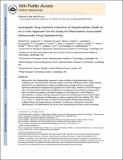Synergistic drug-cytokine induction of hepatocellular death as an in vitro approach for the study of inflammation-associated idiosyncratic drug hepatotoxicity
Author(s)
Xu, Jinghai J.; Hendriks, Bart S.; Cosgrove, Benjamin D.; King, Bracken Matheny; Hasan, Maya A.; Alexopoulos, Leonidas G.; Farazi, Paraskevi A.; Sorger, Peter K.; Tidor, Bruce; Griffith, Linda G.; Lauffenburger, Douglas A.; ... Show more Show less
DownloadLauffenburger-2009-Synergistic Drug.pdf (1.892Mb)
OPEN_ACCESS_POLICY
Open Access Policy
Creative Commons Attribution-Noncommercial-Share Alike
Terms of use
Metadata
Show full item recordAbstract
Idiosyncratic drug hepatotoxicity represents a major problem in drug development due to inadequacy of current preclinical screening assays, but recently established rodent models utilizing bacterial LPS co-administration to induce an inflammatory background have successfully reproduced idiosyncratic hepatotoxicity signatures for certain drugs. However, the low-throughput nature of these models renders them problematic for employment as preclinical screening assays. Here, we present an analogous, but high-throughput, in vitro approach in which drugs are administered to a variety of cell types (primary human and rat hepatocytes and the human HepG2 cell line) across a landscape of inflammatory contexts containing LPS and cytokines TNF, IFNγ, IL-1α, and IL-6. Using this assay, we observed drug–cytokine hepatotoxicity synergies for multiple idiosyncratic hepatotoxicants (ranitidine, trovafloxacin, nefazodone, nimesulide, clarithromycin, and telithromycin) but not for their corresponding non-toxic control compounds (famotidine, levofloxacin, buspirone, and aspirin). A larger compendium of drug–cytokine mix hepatotoxicity data demonstrated that hepatotoxicity synergies were largely potentiated by TNF, IL-1α, and LPS within the context of multi-cytokine mixes. Then, we screened 90 drugs for cytokine synergy in human hepatocytes and found that a significantly larger fraction of the idiosyncratic hepatotoxicants (19%) synergized with a single cytokine mix than did the non-hepatotoxic drugs (3%). Finally, we used an information theoretic approach to ascertain especially informative subsets of cytokine treatments for most highly effective construction of regression models for drug- and cytokine mix-induced hepatotoxicities across these cell systems. Our results suggest that this drug–cytokine co-treatment approach could provide a useful preclinical tool for investigating inflammation-associated idiosyncratic drug hepatotoxicity.
Date issued
2009-06Department
Massachusetts Institute of Technology. Biotechnology Process Engineering Center; Massachusetts Institute of Technology. Cell Decision Process Center; Massachusetts Institute of Technology. Department of Biological Engineering; Massachusetts Institute of Technology. Department of Electrical Engineering and Computer ScienceJournal
Toxicology and Applied Pharmacology
Publisher
Elsevier Ltd.
Citation
Cosgrove, Benjamin D. et al. “Synergistic drug–cytokine induction of hepatocellular death as an in vitro approach for the study of inflammation-associated idiosyncratic drug hepatotoxicity.” Toxicology and Applied Pharmacology 237 (2009): 317-330. Web. 16 Nov. 2011. © 2009 Elsevier Ltd.
Version: Author's final manuscript
ISSN
0041-008X